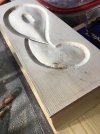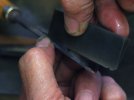Unrelated to sharpening carving tools, the original topic here, is roughing out with a burr tool a 'normal' process?
As the proud owner (not really a user yet) of a flex shaft tool, but NO carving gouges, I am wondering how to get started. Hints or resources?
A YouTube channel from the UK, "Matt Carves" inspired me to try Kutzall burrs. Matt's control of rapidly spinning burrs is akin to hitting a baseball thrown from right to left across home plate and sending it deep to center field. It is awesome. I just acquired an extra-coarse Kutzall extreme rotor saw burr. Though I thought I was braced, one cut of several took me out of the intended path and again left moose tracks. Clearly, it can be done.
Again, I was able to modify and rescue the carving using a conventional gouge. Carvings are imprecise. They are hard to ruin.
If you try these (and I recommend trying for the fun of it), I suggest the coarse burrs, a flame shape and a rotor saw like mine. A light touch leaves no deep grooves. You will chortle at the speed of wood removal. Wear light work gloves to protect your fingers if the hand holding the flex shaft or the workpiece slips. Practice a lot with cut-offs of any wood species.
I have no carving expertise but I love using gouges from 3 to 8 sweep. Try a 7 or 8 to start and for smaller carvings keep the width to 3/8" or less. I like Ashley Iles from Tools for Working Wood. Joel has a great chart to show you what he has in stock. Soon you will want to try other sweeps. You can use a small brass mallet, tapping gently to cut through gnarly pine but usually unassisted hand power is sufficient. There is more control and less tear-out with cross grain cuts and you can remove a lot of wood quickly. Grind the bevel to ~20 degrees. You can do this with a 3 x 18 belt sander sitting upside down in your bench vise. It's quick at 80 grit. The tool won't overheat and you can adjust the angle of approach without a tool rest.
After grinding, smooth the gouge with side-to-side movement on a medium to coarse small diamond plate and follow this with a fine plate until you feel a burr on the inner surface of the gouge. A small round or oval-edge slip stone removes the burr. Mary May's videos are a resource.
Finally, use a buffer (inexpensive Harbor Freight type) with 6" extra thick buffing wheel (Amazon). A little Autosol or your favorite abrasive will give you the best edge you have ever achieved on anything. Hold the gouge at about a 45 - 60 degree downward angle to the downward rotating wheel. You don't want or need a tool rest. Wear eye protection. Take your time. It's all fun.











